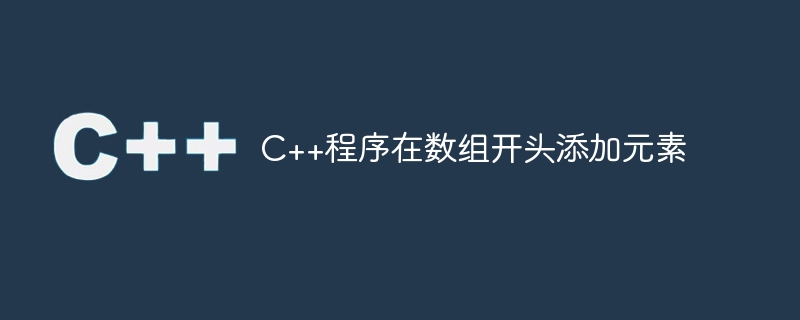
透過使用陣列和資料結構,可以在多個記憶體位置上儲存同質(相同)資料。使用陣列的關鍵好處是我們可以使用索引參數從任何位置檢索它們。這種資料結構變得線性,因為資料必須逐步插入和提取。我們只需要將該元素的索引或位置號碼放在方括號內,就可以從陣列中檢索它。在本文中,我們將使用陣列A和另一個元素e。我們將在C 中將e插入到A的起始位置。
Given array A = [10, 14, 65, 85, 96, 12, 35, 74, 69] After inserting 23 at the end, the array will look like this: [23, 10, 14, 65, 85, 96, 12, 35, 74, 69]
在上面的範例中,我們有一個包含九個元素的陣列A。我們將在陣列A的開頭插入另一個元素23。結果陣列包含了所有元素以及開頭的23。要在開頭插入一個元素,我們必須將所有元素向右移動一個位置,然後第一個插槽將為空,我們將新元素放在該位置。讓我們看一下演算法,以便更清楚地理解。
取一個陣列 A 和一個元素 e
如果陣列 A 有足夠的空間來插入元素 e,則
對於從n-1到0的範圍內的i,執行以下操作:
A[ i 1 ] = A[ i ]
#結束迴圈
A[0]=e
增加 n 1
#結束如果
回傳 A
#include <iostream>
# define Z 50
using namespace std;
void displayArr(int arr[], int n){
for( int i = 0; i < n; i++ ){
cout << arr[ i ] << ", ";
}
cout << endl;
}
void insertAtBeginning( int A[], int &n, int e ){
if( n + 1 < Z ) {
for( int i = n - 1; i >= 0; i-- ) {
A[ i + 1 ] = A[ i ];
}
A[ 0 ] = e;
n = n + 1;
}
}
int main() {
int A[ Z ] = {57, 10, 14, 19, 86, 52, 32, 14, 76, 65, 32, 14};
int n = 12;
cout << "Array before insertion: ";
displayArr( A, n );
cout << "Inserting 58 at the beginning:" << endl;
insertAtBeginning( A, n, 58 );
cout << "Array after insertion: ";
displayArr( A, n );
cout << "Inserting 225 at the beginning:" << endl;
insertAtBeginning( A, n, 225 );
cout << "Array after insertion: ";
displayArr( A, n );
}
Array before insertion: 57, 10, 14, 19, 86, 52, 32, 14, 76, 65, 32, 14, Inserting 58 at the beginning: Array after insertion: 58, 57, 10, 14, 19, 86, 52, 32, 14, 76, 65, 32, 14, Inserting 225 at the beginning: Array after insertion: 225, 58, 57, 10, 14, 19, 86, 52, 32, 14, 76, 65, 32, 14,
向量是一種動態資料結構,它是C STL的一部分。我們可以在向量中獲得與陣列類似的功能。但是在向量中,我們只能在末尾或後面插入。沒有直接的方法可以在開頭插入。然而,我們可以像之前一樣將元素向後移動一個位置,然後在開頭插入新元素。或者我們可以建立另一個只包含新元素的單元素向量,然後將它們連接起來。因此,結果向量將包含所有先前的元素和新元素在開頭。讓我們看一下演算法和C 實作。
取一個陣列 A 和一個元素 e
建立一個空向量 B
#將 e 插入 B 中
A := 將 B 與 A 連接起來(先 B 再 A)
#回傳 A
#include <iostream>
#include <vector>
# define Z 50
using namespace std;
void displayArr( vector<int> v ){
for( int i = 0; i < v.size() ; i++ ){
cout << v[ i ] << ", ";
}
cout << endl;
}
vector<int> insertAtBeginning( vector<int> A, int e ){
vector<int> B( 1 );
B[ 0 ] = e;
B.insert( B.end(), A.begin(), A.end() );
return B;
}
int main() {
vector<int> A = {57, 10, 14, 19, 86, 52, 32, 14, 76, 65, 32, 14};
cout << "Array before insertion: ";
displayArr( A );
cout << "Inserting 58 at the beginning:" << endl;
A = insertAtBeginning( A, 58 );
cout << "Array after insertion: ";
displayArr( A );
cout << "Inserting 225 at the beginning:" << endl;
A = insertAtBeginning( A, 225 );
cout << "Array after insertion: ";
displayArr( A );
}
Array before insertion: 57, 10, 14, 19, 86, 52, 32, 14, 76, 65, 32, 14, Inserting 58 at the beginning: Array after insertion: 58, 57, 10, 14, 19, 86, 52, 32, 14, 76, 65, 32, 14, Inserting 225 at the beginning: Array after insertion: 225, 58, 57, 10, 14, 19, 86, 52, 32, 14, 76, 65, 32, 14,
在本文中,我們已經看到如何在陣列的開頭插入元素。這裡我們討論了兩種不同的解決方案。第一種解決方案使用了靜態的C 數組,而第二種解決方案使用了向量。向量沒有直接在開頭插入元素的方法。我們可以直接在末尾插入元素使用push_back()方法。為此,我們使用了一個技巧,建立一個大小為1的數組,然後將新元素插入其中。然後將其與給定的數組連接起來。我們可以使用列表來實現相同的效果。然而,C 列表有push_front()方法,可以直接在前面插入元素。但是列表不是數組,它們是鍊錶。
以上是C++程式在陣列開頭加入元素的詳細內容。更多資訊請關注PHP中文網其他相關文章!




